Group Project STA 233 PDF

| Title | Group Project STA 233 |
|---|---|
| Course | Introduction Business Forecasting |
| Institution | Universiti Teknologi MARA |
| Pages | 33 |
| File Size | 1.2 MB |
| File Type | |
| Total Downloads | 14 |
| Total Views | 597 |
Summary
Faculty of Computer and Mathematical Science University Teknologi MARA KelantanGROUP ASSIGNMENT:-COVID- 19 DAILY CASES IN ChinaPREPARED BY:NUR ALYA SYAHINDAH BINTI AHMAD SUKRI 2018280428 SITI NURNIERA BASMA BINTI AZEMI 2018800332 NIK AIREEN YASMIN BINTI NIK AZAM 2018273232 SITI NOR SHAZLIN BINTI MOH...
Description
Faculty of Computer and Mathematical Science University Teknologi MARA Kelantan
GROUP ASSIGNM ASSIGNMENT: ENT: ENT:-COVIDOVID-19 19 DA DAILY ILY CA CAS SES IN Ch China ina
Semester
: FEBRUARY 2020- JULY 2020
Course Name
: INTRODUCTORY BUSINESS FORECASTING
Course Code
: STA233
Lecturer’s Name
: MADAM NORAFEFAH MOHAMAD SOBRI
PREPARED BY:
NUR ALYA SYAHINDAH BINTI AHMAD SUKRI
2018280428
SITI NURNIERA BASMA BINTI AZEMI
2018800332
NIK AIREEN YASMIN BINTI NIK AZAM
2018273232
SITI NOR SHAZLIN BINTI MOHAMED SAUFFI
2018405458
PREPARED FOR: NORAFEFAH MOHAMAD SOBRI
1
TABLE OF CONTENT 1.0 INTRODUCTION
3
2.0 PROBLEM STATEMENT
4
3.0 OBJECTIVE
4
4.0 DATA DESCRIPTION
4
5.0 METHODOLOGY 5.1 NAÏVE FORECAST
5
5.2 NAÏVE WITH TREND MODEL
5
5.3 AVERAGE CHANGE MODEL (ACM)
6
5.4 AVERAGE PERCENT CHANGE MODEL (APCM)
6
5.5 SINGLE EXPONENTIAL SMOOTHING
7
5.6 DOUBLE EXPONENTIAL SMOOTHING
7
5.7 HOLT’S METHOD
8
6.0 ANALYSIS & RESULTS 6.1 ACTUAL DATA
9
6.2 NAÏVE FORECAST MODEL
10
6.3 NAÏVE WITH TREND MODEL
11
6.4 AVERAGE CHANGE MODEL (ACM)
12
6.5 AVERAGE PERCENT CHANGE MODEL (APCM)
13
6.6 SINGLE EXPONENTIAL SMOOTHING
14
6.7 DOUBLE EXPONENTIAL SMOOTHING
15
6.8 HOLT’S METHOD
16
7.0 CONCLUSION
17
8.0 APPENDIX
18
2
1.0 Introduction The univariate models belong to data types which require only one variable to be formulated. Univariate modelling as a projective method of forecasting technique where forecast values are generated based on the information as provided by past observations. This is on the assumption that the behaviour of data pattern as depicted in the previous periods will continue in the future. The application of single variable (univariate) models as forecasting exercises, single variable models are less costly to develop and easier to understand. Because of their practicability, other than being useful for quick forecasting exercises, single variable models have become popular techniques among the practitioners and organizations. However, one significant disadvantage is that they lack the necessary explanatory power. Coronavirus disease 2019 (COVID-19) is an infectious disease caused by severe acute respiratory syndrome coronavirus 2 (SARS-CoV-2) (China-WHO Joint Mission, 2020). The disease was first identified in 2019 in Wuhan, the capital of Hubei China, and has since spread globally, resulting in the 2019–20 coronavirus pandemic. The common symptoms of Covid-19 include fever, dry cough, dirrhea and sore throat. While the majority of cases result in mild symptoms, some progress to pneumonia and multi-organ failure. In the month of March 2020, the rate of deaths per number of diagnosed cases is 4.4 percent. However, it ranges from 0.2 percent to 15 percent, according to age group and other health problems. The outbreak of this disease has created a global health crisis that has had a deep impact on the way we perceive our world and our everyday lives. Not only the rate of contagion and patterns of transmission threatens our sense of agency, but the safety measures put in place to contain the spread of the virus also require social distancing by refraining from doing what is inherently human, which is to find solace in the company of others. Our research project will focus on China as this virus started in Wuhan so we think it woild be the bst do research based on where the virus started in 2019 and we use the data from 4th February 2020 to 5th March 2020. The purpose of this forecast are to enhance understanding of the evolving COVID-19 outbreak in China and to analyze the data so we can get the pattern and future trend of the number of cases and death.
3
2.0 Problem Statement As COVID-19 is a newly identified pathogen, there is no known pre-existing immunity in humans. Based on the epidemiologic characteristics and the scenario of increasing Covid19 infected patients throughout the world so far, everyone is assumed to be susceptible, although there may be risk factors increasing susceptibility to infection. So, we do the forecast on the number of cases and deaths due to Covid-19 specifically in China from 4th February 2020 until 5th March 2020 because we want to observe the trend line of cases that occur in China. From the data, we can see that the number of cumulative cases keep on decreasing from 3884 to 143 positive cases and having a turning point on 11th February 2020, then continue decrease. Hence, we need to carry this project to know the safety and health of people in China.
3.0 Objective -
To study the pattern model of data about corona virus happened in China. To determine the most suitable model to analyze data short term like corona virus. To derive accurate forecast values about corona virus for the up coming days.
4.0 Data Description A novel corona virus, 2019-nCov has been identified as the cause of an outbreak of respiratory illness that originated in Wuhan, China and which has spread to several other countries around the world. This virus may cause death. Other than that, this virus also can spread between people during close contact, most often via smack droplets produced by coughing, sneezing and talking. After that, as we can refer the data the variable that have been recorded in this research is the number of new positive cases between 4th February 2020 until 5th March 2020. The total of the new positive cases for 4th February 2020 until 5th March 2020 is 60112 cases. Based on the data, 3884 positive cases were recorded on 4th February 2020 meanwhile on 12th February 2020, 14108 positive cases were recorded. This is prove that the virus spread very fast among citizens in the country.
4
5.0 Methodology Univariate Modelling Technique 5.1 Naïve Forecast
This model assumes a strong deterministic relation, which states that, the current event will determine the future outcome. This model works best when the actual historical data series contain no discernible pattern.
Ft m yt
form = 1, 2, 3, 4,…
Where m refers to the number of periods into future for which the forecast is desired and is yt actual value at time t.
5.2 Naïve with Trend Model
The Naïve Model is modified to take into account of trend component. It is used to overcome problem of insufficient data, which is commonly happen in the organization. This model can be used even with short tine series. The one-step-ahead forecast is represented as;
Ft 1
yt 2 yt 1
Where y t is the actual value at time t1 and y t 1 is the actual value in the preceding period.
5
5.3 Average Change Model (ACM)
It is given as;
Ft m yt Average of Change
Where Average of Change
This model is similar to the naïve with trend model, with the exception that is less influence by all historical observation and its responses relatively quickly to changes in the actual time series. The model is most useful when the historical data being analysed are characterized by period-to-period changes that are approximately of the same size.
5.4 Average Percent Change Model (APCM)
The model assumes that the forecast of the dependent variable equal to the actual level of that variable in the current time period plus the average of the percentage changes from one time period to the next. It can be formally stated as;
Ft m yt Average of Percent Changes
yt yt 1 yt 1 yt 2 y y t 2 1 t Where the Average of Percent Changes 2
6
yt
5.5 Single Exponential Smoothing
The general equation for single exponentially smoothed statistics is given as; Ft m y t (1 ) Ft
Where, F t m is the single exponentially smoothed value in period t m (this is also defined
as forecast value when generated out of sample), for m 1,2,3,4 ,..., yt
is the actual value in time period t,
is the unknown smoothing constant to be determined with value lying
between 0 and 1, i.e. 0 1 , selected by the forecaster or alternatively determined by the data and Ft
is the forecast or smoothed value for period t.
5.6 Double Exponential Smoothing
This technique is also known as Brown’s method. It is useful for series that exhibits a linear trend characteristic. To demonstrate the method the following notations will be used:
Let,
S t1 be the exponentially smoothed valued of y t1 , at time t. S t1 be the double exponentially smoothed value of y t , at time t.
Generally, there are 4 main equation involved
S t y t (1 ) S t 1 S t S t (1 )S 't 1
t 25t S't Ft m 1 b1
7
5.7 Holt’s Method
This technique used to handle data with linear trend. This technique not only smooth the trend the slope directory by using different soothing constant but also provides more flexibility in selecting the rated at which the trend and slopes are tracked.
The application of Holt’s Method requires 3 equations:-
S t yt (1 )( St 1 Tt 1 ) S t ( S t St 1 ) (1 )Tt 1 Ft m S t Tt m
8
6.0 Analysis & Results 6.1 ACTUAL DATA
Daily Positive Cases of Covid-19 in China 16000
Number of positive cases
14000 12000 10000 8000 6000 4000 2000 0 -2000
Date
Figure 6.1 Figure 6.1 shows the number of new positive cases in China who had infected with Covid-19 from 4th February 2020 to 5th March 2020. The graph is subjected to downward trend (decrease) and having a turning point. This trend continue falling down from 4th February 2020 to 11th February 2020. The trend turn to record rising up in the number of positive cases of covid-19 on 12th February 2020. Then, the number of positive cases continue to record a drop again on 13th February 2020 to 5th March 2020. This figure has no cyclical trend and the seasonal trend does not exist.
9
6.2 NAÏVE FORECAST
Naïve Forecast Model 16000
Number of positive cases
14000 12000 10000 8000 6000 4000 2000 0
Date Number of positive cases
Naïve Forecast
Figure 6.2 NAÏVE FORECAST
MSE
MAPE
ESTIMATION
10814626.9545
59.7596
EVALUATION
23321.7500
27.0755
Figure 6.2 shows the number of positive cases recorded in China using naïve forecast model. It can be concluded that the model has a turning point on 12th February 2020. Most of the fitted value is slightly approaches the actual values apart from 11th February 2020 and 20th March 2020. The value of MSE in estimation is 10814626.9545 while in evaluation is 23321.7500. The value of MAPE in estimation is 59.7596 while in evaluation is 27.0755.
10
6.3 NAÏVE WITH TREND MODEL
Naïve with Trend Model Number of positive cases
120000 100000 80000 60000 40000
20000 0
Date Number of positive cases
Naïve Trend
Figure 6.3 NAÏVE WITH TREND
MSE
MAPE
ESTIMATION
425792474.6126
151.3861
EVALUATION
47236.0500
59.6000
Figure 6.3 shows a graph between fitted value of naïve with trend model and actual data of number of positive cases. It can be concluded that this model has suddenly record a drop on 13th February 2020. It makes the trend become continue with constant data. Most of the fitted value is slightly approaches the actual values. The value of MSE and MAPE in the estimation part is 425792474.6126 and 151.3861. Meanwhile, the value of MSE and MAPE in the evaluation part is 47236.0500 and 59.6000.
11
6.4 AVERAGE CHANGE MODEL
Average Change Model
Number of positive cases
25000 20000 15000 10000
5000 0 -5000
Date Number of positive cases
Average change model
Figure 6.4 AVERAGE CHANGE MODEL
MSE
MAPE
ESTIMATION
21383992.2500
90.2744
EVALUATION
42870.6250
72.7639
Based on the Figure 6.4 above, there is a downward trend in the number of new positive cases in China from 18th February 2020 until 11th February 2020. The graph continue falling from 13th February 2020 until 5th March 2020. Its shows that the fitted value is slightly approaches the actual values. After developed average change model by using Microsoft Excel, we obtained the value of MSE in estimation is 21383992.2500 while in evaluation is 42870.6250. The value of MAPE in estimation is 90.2744 while in evaluation is 72.7639.
12
6.5 AVERAGE PERCENT CHANGE MODEL
Average Percent Change Model Number of positive cases
60000 50000 40000 30000 20000 10000 0
Date Number of positive cases
Average percent change model
Figure 6.5 AVERAGE PERCENT CHANGE MODEL
MSE
MAPE
ESTIMATION
146273316.8
136.9686
EVALUATION
44709.4053
59.2756
Based on the graph above, average percent change model has a downward trend in the number of new positive cases in China from 14th February 2020 until 5th March 2020. The graph shows fitted value is slightly approaches the actual values. The value of MSE in estimation can be obtain after developed average change model using Microsoft Excel, while in evaluation is 44709.4053. The value of MAPE in estimation is 136.9686 while in evaluation is 59.2756.
13
6.6 SINGLE EXPONENTIAL SMOOTHING
Single Exponential Smoothing 16000
Number of cases
14000 12000 10000 8000 6000 4000 2000 0
Date Number of positive cases
Single exponential smoothing
Figure 6.6 SINGLE EXPONENTIAL SMOOTHING
MSE
MAPE
ESTIMATION
10344425.78
54.2224
EVALUATION
23321.7500
43.6008
The graph shows that there is a downward trend in the number of new positive cases in China from 13th February 2020 to 5th March 2020. Next, most of the fitted value is slightly approaches the actual values. By using Solver in Microsoft Excel, we found out that the best alpha is 1, it is also can obtain the value of MSE in estimation which is 10344425.78 while in evaluation is 23321.7500. The value of MAPE in estimation is 54.2224, while in evaluation is 43.6008.
14
6.7 DOUBLE EXPONENTIAL SMOOTHING
Double Exponential Smoothing 16000
Number of positive cases
14000 12000 10000
8000 6000 4000 2000 0 -2000
Date Number of positive cases
Double exponential smoothing
Figure 6.7 DOUBLE EXPONENTIAL SMOOTHING
MSE
MAPE
ESTIMATION
11896893.3611
60.4036
EVALUATION
28060.1123
64.6098
Figure 6.7 shows double exponential smoothing technique. It shows an upward trend in the number of new positive cases in China from 5th February 2020 to 8 February 2020 and 12th February 2020, then it started to fall. Most of the fitted value is mostly approaches from actual values. By using Solver in Microsoft Excel, we found that the best alpha is 0.531277646. The value of MSE in estimation is 11896893.3611 while evaluation is 28060.1123. The value of MAPE in estimation is 60.4036 while in evaluation is 64.6098.
15
6.8 HOLT’S METHOD
Holt's Method Number of positive cases
50000 45000 40000 35000 30000 25000 20000 15000 10000 5000 0
Date Number of positive cases
Holt's Method
Figure 6.8 HOLT’S METHOD
MSE
MAPE
ESTIMATION
1578032470.0435
4262.0550
EVALUATION
1903918765.3750
23319.5239
The graph shows the model of Holt’s Method, there is an upward trend in the number of new positive cases in China. Most of the fitted value is mostly not approaches from actual values. By using Solver in Microsoft Excel, it found that the best parameter 𝛼 = 1.0 and 𝛽 = 0. The value of MSE in estimation is 1578032470.0435 while evaluation is 1903918765.3750. The value of MAPE in estimation is 4262.0550 while in evaluation is 23319.5239.
16
7.0 Conclusion MAPE
MSE MODEL
Naïve Forecast
ESTIMATION
EVALUATION
ESTIMATION
EVALUATION
10814626.9545
23321.7500
59.7596
27.0755
425792474.6126
47236.0500
151.3861
59.6000
21383992.2500
42870.6250
90.2744
72.7639
146273316.8
44709.4053
136.9686
59.2756
10344425.78
23321.7500
54.2224
43.6008
11896893.3611
28060.1123
60.4036
64.6098
1578032470.0435
1903918765.3750
4262.0550
23319.5239
Naïve with Trend Average Change Average Percent Change Single Exponential Smoothing Double Exponential Smoothing Holt’s Method
A very good fit model is a model with the smallest Mean Squared Error (MSE) and Mean Absolute Percentage Error (MAPE) in evaluating part. From the table above, the comparison are state between MSE and MAPE values in estimation and evaluation part between all of the models. It shows that, from the entire model above in methodology Naive Forecast has the smallest MSE and MAPE values for evaluation. Hence, Naïve Forecast could be the best forecasting models that can perform the forecast of the new positive cases of covid-19 in China.
17
8.0 Appendix 1) Actual Data Date
Number of positive cases
4-Feb-20
3884
5-Feb-20
3694
6-Feb-20
3143
7-Feb-20
3385
8-Feb-20
2652
9-Feb-20
2973
10-Feb-20
2467
11-Feb-20
2015
12-Feb-20
14108
13-Feb-20
5090
14-Feb-20
2641
15-Feb-20
2008
16-Feb-20
2048
17-Feb-20
1888
18-Feb-20
1749
19-Feb-20
391
20-Feb-20
889
21-Feb-20
823
22-Feb-20
648
23-Feb-20
214
Similar Free PDFs
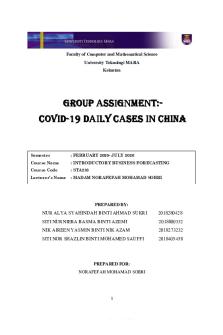
Group Project STA 233
- 33 Pages
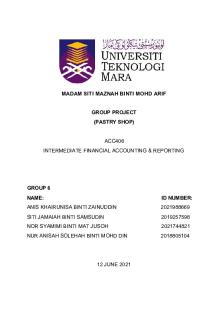
Group Project Account ( Group 6)
- 21 Pages
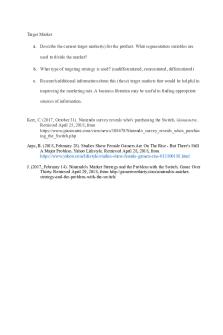
Group Project- Target Market
- 4 Pages
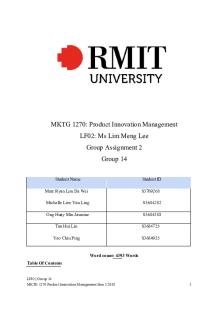
PIM Group Project 2
- 68 Pages
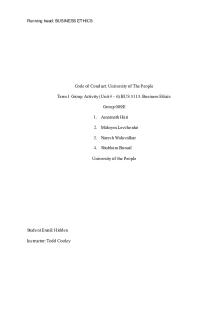
Group Project 009E Final
- 21 Pages
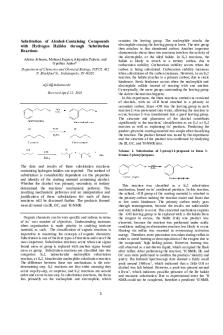
Group Project JOC Note
- 4 Pages

Group Project Proposal
- 1 Pages
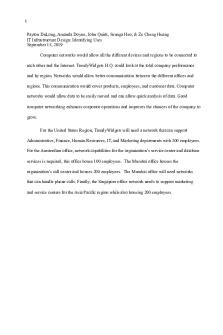
IST Group Project
- 19 Pages

Group project guidelines
- 1 Pages

group project sta108
- 55 Pages

CSR Group Project ASM401
- 18 Pages

MNT group Project
- 9 Pages

Victoria\'s Secret Group Project
- 11 Pages

CSC264 Group Project
- 8 Pages

Project MAT575 Group 1
- 9 Pages

Group project-TB
- 31 Pages
Popular Institutions
- Tinajero National High School - Annex
- Politeknik Caltex Riau
- Yokohama City University
- SGT University
- University of Al-Qadisiyah
- Divine Word College of Vigan
- Techniek College Rotterdam
- Universidade de Santiago
- Universiti Teknologi MARA Cawangan Johor Kampus Pasir Gudang
- Poltekkes Kemenkes Yogyakarta
- Baguio City National High School
- Colegio san marcos
- preparatoria uno
- Centro de Bachillerato Tecnológico Industrial y de Servicios No. 107
- Dalian Maritime University
- Quang Trung Secondary School
- Colegio Tecnológico en Informática
- Corporación Regional de Educación Superior
- Grupo CEDVA
- Dar Al Uloom University
- Centro de Estudios Preuniversitarios de la Universidad Nacional de Ingeniería
- 上智大学
- Aakash International School, Nuna Majara
- San Felipe Neri Catholic School
- Kang Chiao International School - New Taipei City
- Misamis Occidental National High School
- Institución Educativa Escuela Normal Juan Ladrilleros
- Kolehiyo ng Pantukan
- Batanes State College
- Instituto Continental
- Sekolah Menengah Kejuruan Kesehatan Kaltara (Tarakan)
- Colegio de La Inmaculada Concepcion - Cebu